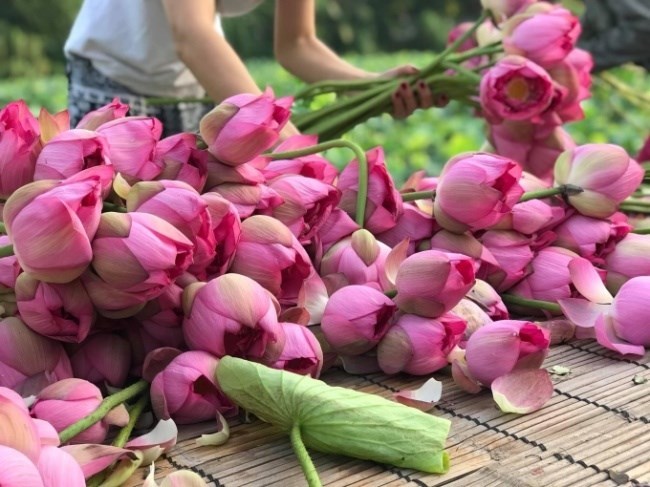Lotus Bach Diep (Lotus from West Lake) is a precious variety, but now gradually degenerates. Currently, the lotus growing area in West Lake is increasingly narrowed. The question for the reaseach group is how to have a reliable source of lotus seeds? If we only breed by separating bud, the breeding coefficient will be low, easily degenerating, and at risk of steadily losing the outstanding features of this lotus species.
Assoc. Prof. Dr. Dong Huy Gioi, Vietnam National University of Agriculture, with his associates, has collected theoriginal genetic resources in the growing areas in West Lake to store the original varieties at the Center for Conservation, Exploitation and Development of Lotus genes. From this original seed, he uses cell culture method to create a dependable source of lotus seed. This method preserves the characteristics of lotus that helps protect lotus against the pest. The invitro study was successful, and more than 500 samples of varieties were just brought to the incubating garden to assess the result.
    |
 |
| Bach Diep Lotus grown in West Lake is a precious source of genes |
According to Assoc. Prof. Dr. Gioi, Bach Diep lotus is a long-standing lotus that has been grown for a long time in the West Lake area - Hanoi. This lotus is named Bach Diep because each flower has up to 100 petals. Its Easily recognizable features are double petals with pink color, long fragrance, large and succulent lotus anther. The most popular function of Bach Diep lotus is to marinate tea due to its long-lasting and rich aroma.
Assoc. Prof. Dr. Dang Van Dong, Deputy Director of the Research Institute of Vegetables and Fruits, who has spent many years researching lotus flowers, said that in fact many precious lotus species/varieties of Vietnam are being degraded, so the conservation, preservation, restoration and development of lotus flowers are essential.
Normally, people can choose the best lotus with valuable characteristics from the group plants to grow separately, then breed by seeds (applicable to purebred varieties) or propagate by underground stem/tubers in the desease-free environment, which will produce good varieties and keep the positive traits of the original variety. However, Assoc. Prof. Dong said that to ensure the efficiency of conservation and restoration process and the good quality seedlings, the cell culture method is the most optimal method. Cell culture allows us to create a large number of seedlings in a short time, and the multiplied plants still retain the original traits of the mother lotus, thereby preserving the lotus genetic source.
West Lake lotus is classified as a rare and special genetic resource that needs to be preserved. In 2017, scientists from the Plant Resources Center, Vietnam National University of Agriculture researched and provided a number of morphological characteristics to identify the West Lake lotus variety.
From this study, Bach Diep lotus species were identified: Dark green leaves, petioles and light green flower stalks. Each leaf has 20-22 veins with the rought leaf blade. The flower buds are long, oblong, and pale pink. Double petals are pink with flat lotus seed pod and long oval lotus seeds. Each West Lake lotus has an average of about 100 petals. Lotus seeds are arranged in 3 concentric circles on the lotus seed-pod: the first round consists of 1-5 seeds, the second round consists of 5-12 seeds and the third round consists of 10-17 seeds.
Dr. Gioi hopes that the process of bringing seedlings to the nursery garden will bring about fruitful results. This will be a source of high quality Bach Diep lotus seeds for people to grow and develop their business.